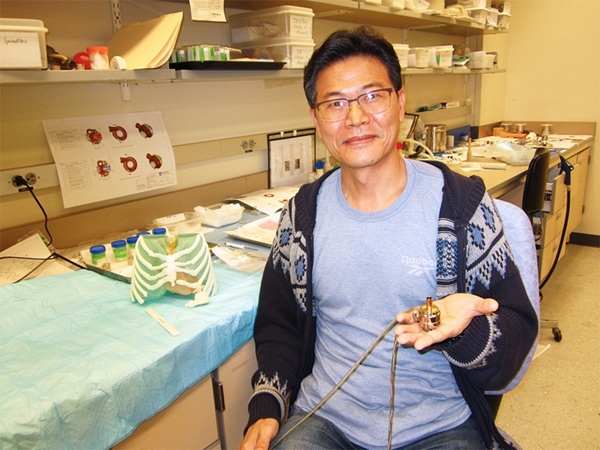Home-Based System Relieves Cirrhosis Refractory Ascites
|
By HospiMedica International staff writers Posted on 11 Jan 2022 |

Image: An ascites patient with abdominal paracentesis scars (Photo courtesy of iStock)
A novel tunneled peritoneal catheter (PeCa) drainage system provided significant relief for patients with refractory ascites, according to a new study.
The PeCa implant, developed at Hannover Medical School (Germany), is composed of internal shut that lies in the peritoneal cavity, a tunneled section that passes through subcutaneous tissue, and an external port to which drainage bags are connected. To test system efficacy, outcomes in 152 patients with refractory ascites, who were not candidates for transjugular intrahepatic portosystemic shunt (TIPS) and received a PeCa implant, were compared to 71 patients who received standard care, which included repeated large volume paracentesis and albumin.
The results revealed that factors associated with 90-day survival were PeCa implantation, and each point of Model for End-Stage Liver Disease (MELD) score. Hospitalizations were more common in the PeCa group, for reasons that included spontaneous bacterial peritonitis (SBP), hyponatremia, and infections other than SBP. There was no significant difference in mortality between the two groups, but there were trends in the PeCa group towards higher frequency of acute kidney injury (AKI). The study was presented at the American Association for the Study of Liver Diseases annual conference, held online during November 2021.
“Patients with refractory ascites have a very high risk for rehospitalization, AKI, and death. Our data indicate that PeCa could be a valuable new treatment option for patients with refractory ascites and contraindication for TIPS,” said study co-author and presenter Tammo Lambert Tergast, MD. “I think if we can optimize the treatment after discharge, we can also minimize the rehospitalization in these patients. However, the risk for hyponatremia and AKI has to be considered and further explored.”
Refractory ascites occurs when patients no longer respond to medical therapy, a condition that affects over 100,000 patients in Europe and the United States every year, a number that is growing at approximately 10% a year. The primary treatment for ascites is paracentesis, a procedure in which a large bore needle is inserted into the patient's abdomen to remove between 5‐10 liters of ascites that has accumulated over a period of a week or two.
Related Links:
Hannover Medical School
The PeCa implant, developed at Hannover Medical School (Germany), is composed of internal shut that lies in the peritoneal cavity, a tunneled section that passes through subcutaneous tissue, and an external port to which drainage bags are connected. To test system efficacy, outcomes in 152 patients with refractory ascites, who were not candidates for transjugular intrahepatic portosystemic shunt (TIPS) and received a PeCa implant, were compared to 71 patients who received standard care, which included repeated large volume paracentesis and albumin.
The results revealed that factors associated with 90-day survival were PeCa implantation, and each point of Model for End-Stage Liver Disease (MELD) score. Hospitalizations were more common in the PeCa group, for reasons that included spontaneous bacterial peritonitis (SBP), hyponatremia, and infections other than SBP. There was no significant difference in mortality between the two groups, but there were trends in the PeCa group towards higher frequency of acute kidney injury (AKI). The study was presented at the American Association for the Study of Liver Diseases annual conference, held online during November 2021.
“Patients with refractory ascites have a very high risk for rehospitalization, AKI, and death. Our data indicate that PeCa could be a valuable new treatment option for patients with refractory ascites and contraindication for TIPS,” said study co-author and presenter Tammo Lambert Tergast, MD. “I think if we can optimize the treatment after discharge, we can also minimize the rehospitalization in these patients. However, the risk for hyponatremia and AKI has to be considered and further explored.”
Refractory ascites occurs when patients no longer respond to medical therapy, a condition that affects over 100,000 patients in Europe and the United States every year, a number that is growing at approximately 10% a year. The primary treatment for ascites is paracentesis, a procedure in which a large bore needle is inserted into the patient's abdomen to remove between 5‐10 liters of ascites that has accumulated over a period of a week or two.
Related Links:
Hannover Medical School
Latest Patient Care News
- Revolutionary Automatic IV-Line Flushing Device to Enhance Infusion Care
- VR Training Tool Combats Contamination of Portable Medical Equipment
- Portable Biosensor Platform to Reduce Hospital-Acquired Infections
- First-Of-Its-Kind Portable Germicidal Light Technology Disinfects High-Touch Clinical Surfaces in Seconds
- Surgical Capacity Optimization Solution Helps Hospitals Boost OR Utilization

- Game-Changing Innovation in Surgical Instrument Sterilization Significantly Improves OR Throughput
- Next Gen ICU Bed to Help Address Complex Critical Care Needs
- Groundbreaking AI-Powered UV-C Disinfection Technology Redefines Infection Control Landscape
- Clean Hospitals Can Reduce Antibiotic Resistance, Save Lives
- Smart Hospital Beds Improve Accuracy of Medical Diagnosis
- New Fast Endoscope Drying System Improves Productivity and Traceability
- World’s First Automated Endoscope Cleaner Fights Antimicrobial Resistance
- Portable High-Capacity Digital Stretcher Scales Provide Precision Weighing for Patients in ER
- Portable Clinical Scale with Remote Indicator Allows for Flexible Patient Weighing Use
- Innovative and Highly Customizable Medical Carts Offer Unlimited Configuration Possibilities
- Biomolecular Wound Healing Film Adheres to Sensitive Tissue and Releases Active Ingredients
Channels
Critical Care
view channel
Breathable Electronic Skin Paves Way for Next-Generation Wearable Devices
Electronic skin devices are designed to adhere closely to the human body to monitor health and biosignals, but long-term use often leads to skin irritation caused by trapped sweat and poor breathability.... Read more
AI Transforming Colon Cancer Diagnosis
Colon cancer remains one of the most common and deadly cancers worldwide, with diagnosis often relying on time-consuming procedures such as colonoscopy and histopathological analysis. Delays or inaccuracies... Read more
Ventricular Assist Device Offers Long-Term Use in Children Waiting for Donor Heart
Children with severe heart failure often face long and dangerous waits for a donor heart, with limited options to keep them stable during this period. For patients between the ages of one and 11, there... Read more
Precision Approach Improves Immunotherapy Effectiveness for ICU Patients with Sepsis
Sepsis occurs when the immune system responds abnormally to an infection, often triggering life-threatening organ failure. Despite affecting around 49 million people globally each year and causing approximately... Read moreSurgical Techniques
view channel
Minimally Invasive Surgery Proven Safe and Effective for Complex ‘Whipple’ Procedure
Tumors of the pancreatic head often require a highly complex operation known as pancreatoduodenectomy or the Whipple procedure. This surgery involves removing multiple structures and creating several internal... Read more
Catheter-Based Procedures Offer Less Invasive Option for Treatment of Valvular Disease
Valvular heart disease, caused by tight or leaky valves between heart chambers, affects up to 10% of older adults and leads to more than 120,000 deaths globally each year. Traditional open-heart surgery... Read moreHealth IT
view channel
EMR-Based Tool Predicts Graft Failure After Kidney Transplant
Kidney transplantation offers patients with end-stage kidney disease longer survival and better quality of life than dialysis, yet graft failure remains a major challenge. Although a successful transplant... Read more
Printable Molecule-Selective Nanoparticles Enable Mass Production of Wearable Biosensors
The future of medicine is likely to focus on the personalization of healthcare—understanding exactly what an individual requires and delivering the appropriate combination of nutrients, metabolites, and... Read moreBusiness
view channel
Philips and Masimo Partner to Advance Patient Monitoring Measurement Technologies
Royal Philips (Amsterdam, Netherlands) and Masimo (Irvine, California, USA) have renewed their multi-year strategic collaboration, combining Philips’ expertise in patient monitoring with Masimo’s noninvasive... Read more
B. Braun Acquires Digital Microsurgery Company True Digital Surgery
The high-end microsurgery market in neurosurgery, spine, and ENT is undergoing a significant transformation. Traditional analog microscopes are giving way to digital exoscopes, which provide improved visualization,... Read more
CMEF 2025 to Promote Holistic and High-Quality Development of Medical and Health Industry
The 92nd China International Medical Equipment Fair (CMEF 2025) Autumn Exhibition is scheduled to be held from September 26 to 29 at the China Import and Export Fair Complex (Canton Fair Complex) in Guangzhou.... Read more













